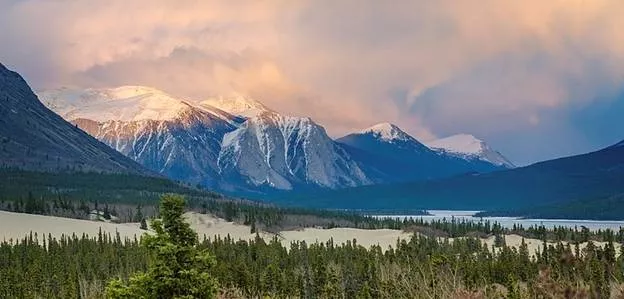View Other Topics.
 Jun 11, 2020
Jun 11, 2020
Image: Carcross Desert and Nares Lake - wikipedia.org
No, your eyes aren't deceiving you, that's a sandy desert with picturesque mountain backdrop you see in the photo above. Even stranger? It's located just outside of Carcross, in Yukon, Canada according to weather.com.
Known as Carcross Desert, the site might just be the smallest desert in the world. At just about one square mile in area, the Carcross Desert is actually smaller than the "Mile Square City" of Hoboken, New Jersey, which in fairness is actually more like two square miles in size.
But technically, Carcross isn't actually a desert because the area receives too much precipitation year-to-year. But the area is still quite dry due to two factors related to its unique locale, according to weather.com senior meteorologist Jonathan Erdman.
"First, the Carcross Desert sits in a 'rain shadow'. Moist winds from the northeast Pacific are intercepted by the mountains to its west and south, robbing most of the rain and snow of those moisture-laden storms," said Erdman. "Second, the moistest time of year along the Gulf of Alaska coast is also the time when bitterly cold, dry Arctic air masses build into the Yukon Territory from Siberia and Alaska, further depriving the area of potential for precipitation."
As the USGS notes, in order to be considered a true desert, areas must either go at least 12 straight months without rainfall or receive less than 9.84 inches of rain a year. Nearby Whitehorse, Yukon, doesn't fit the criteria. Whitehorse averages a little more than 10 inches of rain a year, though Erdman said Carcross likely receives less.
So, in reality, "desert" is just a moniker. Instead, the rolling sandy expanse you see is actually made up of dunes. More than 10,000 years ago, during the last Ice Age, a glacial lake known as Watson Lake existed in place of the dunes, Environment Yukon reports. When temperatures warmed, and the glaciers that fed Watson Lake disappeared, so did the lake. All that was left behind was sand and silt, which remains the foundation for Carcross "desert" today.
And that started an entirely new environmental process, one that still operates today. The Watson River started cutting through the area just after the glacial melt, slowly transporting large quantities of sand and silt into nearby Bennet Lake. Now, strong winds that funnel through the mountains push that sand and silt onshore and into Carcross, forming and maintaining the dunes.
Two rare plants – the Baikal Sedge (endangered) and the Yukon Lupine – found only in this area, line the dunes and prevent wind erosion, according to Environment Yukon.
Carcross is also a major recreational destination for locals and tourists, who ride ATVs, hike and sandboard on the dunes. Potential dune erosion from those activities prompted the government to seek out environmental protection for the "desert" back in 1992, but that measure failed due to pushback from community members.
Tags:
#history,#canada,#starzpsychicsnetwork,#starzpsychics,#starz#advisors
The World's Smallest Desert Is in ... Canada?.

Image: Carcross Desert and Nares Lake - wikipedia.org
No, your eyes aren't deceiving you, that's a sandy desert with picturesque mountain backdrop you see in the photo above. Even stranger? It's located just outside of Carcross, in Yukon, Canada according to weather.com.
Known as Carcross Desert, the site might just be the smallest desert in the world. At just about one square mile in area, the Carcross Desert is actually smaller than the "Mile Square City" of Hoboken, New Jersey, which in fairness is actually more like two square miles in size.
But technically, Carcross isn't actually a desert because the area receives too much precipitation year-to-year. But the area is still quite dry due to two factors related to its unique locale, according to weather.com senior meteorologist Jonathan Erdman.
"First, the Carcross Desert sits in a 'rain shadow'. Moist winds from the northeast Pacific are intercepted by the mountains to its west and south, robbing most of the rain and snow of those moisture-laden storms," said Erdman. "Second, the moistest time of year along the Gulf of Alaska coast is also the time when bitterly cold, dry Arctic air masses build into the Yukon Territory from Siberia and Alaska, further depriving the area of potential for precipitation."
As the USGS notes, in order to be considered a true desert, areas must either go at least 12 straight months without rainfall or receive less than 9.84 inches of rain a year. Nearby Whitehorse, Yukon, doesn't fit the criteria. Whitehorse averages a little more than 10 inches of rain a year, though Erdman said Carcross likely receives less.
So, in reality, "desert" is just a moniker. Instead, the rolling sandy expanse you see is actually made up of dunes. More than 10,000 years ago, during the last Ice Age, a glacial lake known as Watson Lake existed in place of the dunes, Environment Yukon reports. When temperatures warmed, and the glaciers that fed Watson Lake disappeared, so did the lake. All that was left behind was sand and silt, which remains the foundation for Carcross "desert" today.
And that started an entirely new environmental process, one that still operates today. The Watson River started cutting through the area just after the glacial melt, slowly transporting large quantities of sand and silt into nearby Bennet Lake. Now, strong winds that funnel through the mountains push that sand and silt onshore and into Carcross, forming and maintaining the dunes.
Two rare plants – the Baikal Sedge (endangered) and the Yukon Lupine – found only in this area, line the dunes and prevent wind erosion, according to Environment Yukon.
Carcross is also a major recreational destination for locals and tourists, who ride ATVs, hike and sandboard on the dunes. Potential dune erosion from those activities prompted the government to seek out environmental protection for the "desert" back in 1992, but that measure failed due to pushback from community members.
Share this article with friends!
Tags:
#history,#canada,#starzpsychicsnetwork,#starzpsychics,#starz#advisors






